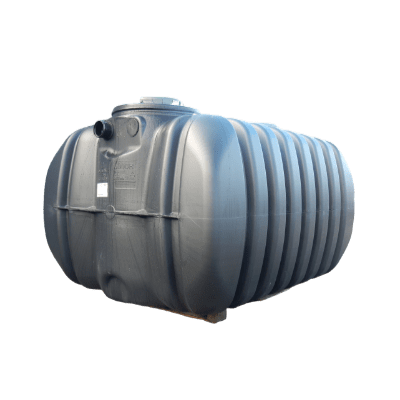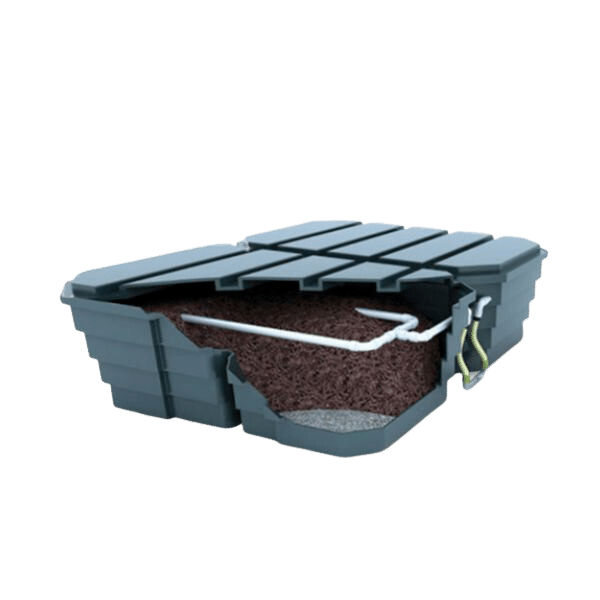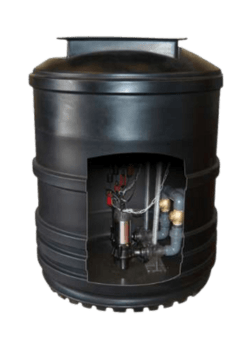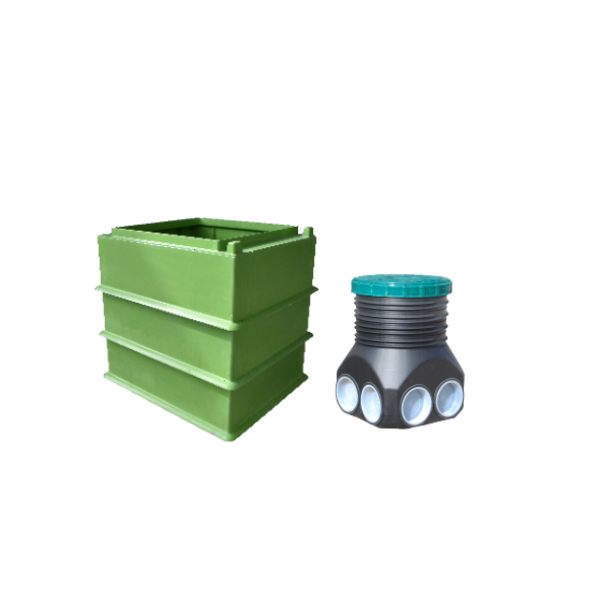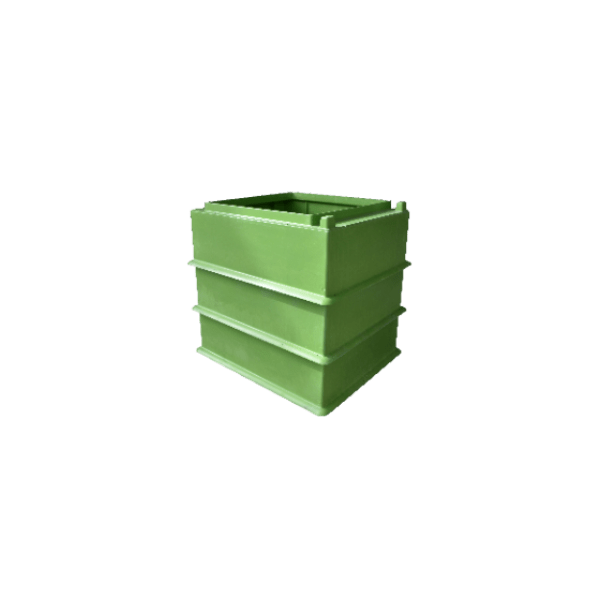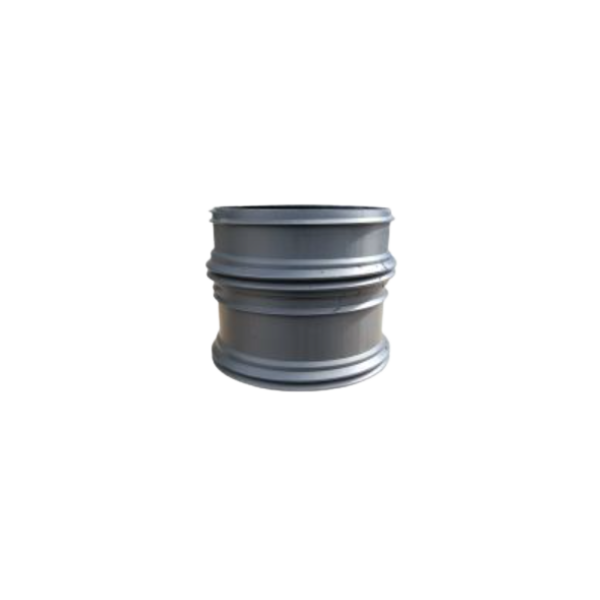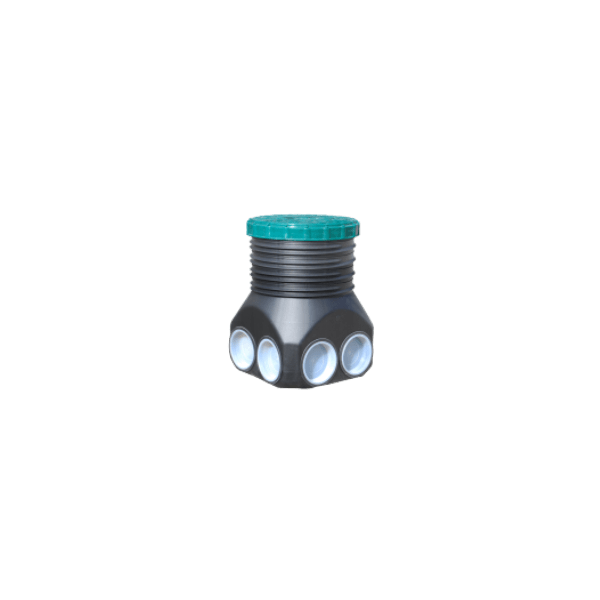SEWAGE TREATMENT
How does a sewage treatment plant work?
OVERVIEW
Domestic sewage treatment plants are a relatively recent invention. They were created as sophisticated alternatives to septic tank systems. They are primarily used in parts of the UK where mains drainage is unavailable. Of course, since domestic sewage treatment plants are a relatively new technology, people need to become more familiar with them. Occasionally, someone will ask, “How does a domestic sewage treatment plant work?” Read on to learn all about the ins and outs of the functions of domestic sewage treatment plants!
KEY BENEFITS OF A TRICEL NOVO PLANT:
- Compact: about five m² of floor space (for five or six population equivalents);
- Lightweight: (200 to 300 kg): easy and inexpensive installation (sewage treatment plant with concrete tank weights more than two tons);
- Efficient: effective treatment, no risk of clogging;
- Adaptable: suitable for all types of terrain (difficult ground, the presence of groundwater);
- Reliable: long life (20 to 40 years, whereas the spreading of a traditional die must be replaced every 10 to 20 years);
- Tested and certified: for structural strength, water tightness, durability and treatment efficiency, adhering to European Standard EN12566- 3 (like all sewage treatment solutions manufactured by Tricel)
If you have any questions, feel free to call us
VISIT OUR VIRTUAL SHOWROOM
Early Sewage Treatment Processes
The process of treating domestic sewage consists of a series of filters. Each filter removes a certain kind of contaminant from the water. As a good rule of thumb, earlier treatments will remove larger contaminants, while later treatments will remove smaller contaminants.
The first filter in a domestic sewage treatment plant consists of a simple screen, and this first screen will have relatively large holes.
It is not designed to make the water any cleaner, instead, its purpose is to remove any large objects from the water.
These objects will generally consist of plant material like sticks or bunches of leaves. In some cases, they also include items like rags disposed of improperly.
It is important to remove these items so that the treatment plant remains free from the damage they can cause to more delicate processes later on.
The following two parts of early treatment at domestic sewage plants rely on gravity to clean water. They run water through a series of chambers.
In each chamber, the water flows for some time before moving on to the next chamber. The chambers have short walls that the water flows over.
The result is that the heaviest contaminants in the water sink to the bottom of the chambers. This allows the water to flow to the next chamber, free of those heavier contaminants.
The first couple of tanks like these remove contaminants like grit and sedimentation.
Later Domestic Sewage Plant Processes
Later stages in the treatment process address subtler contaminants. These include organic and chemical pollutants.
The water is run through a series of interlocking corrugated plastic sheets. There are particular bacteria on the sheets that eat up many organic contaminants.
Later on, the water will be mixed with chlorine to disinfect it. At the end of the process, the water will not yet be ready to drink or wash with, but it will be safe to return to the environment.
Learn How a Domestic Sewage Treatment Plant Works
Suppose you have ever wondered how a domestic sewage treatment plant works. In that case, this brief article on the subject has increased your understanding. Along with septic tanks, domestic sewage treatment plants are one of the best options for managing the waste products of an ordinary home. Regardless of which of these options you choose, it is important to find a quality provider.
To learn more about domestic security plans, septic tanks, and more, feel free to reach out to us
anytime here!
How do sewage treatment plants work?
Stage 1: the primary settlement chamber
In the first sewage treatment stage, anaerobic breakdown occurs in the primary settlement chamber. The wastewater is introduced, and the solids drop to the bottom, becoming separated from the liquid.
Stage 2: the aeration chamber
The next stage of wastewater treatment involves aerobic breakdown. This occurs in the aeration chamber, where masses of naturally occurring bacteria inhabit specially designed filter media.
These bacteria are sustained with air, continuously supplied from a purpose-built pump in the unit’s top section. As the liquid flows slowly through the filter media, the bacteria feed on the waste and remove it from the liquid.
Stage 3: final settlement chamber
In the last stage of wastewater treatment, the liquid flows from the aeration chamber into the final settlement chamber. Suspended sludge consisting of bacteria is carried with the liquid into the settlement chamber. It settles to the bottom of the chamber.
From there, a continuous sludge return system pumps it back to the primary settlement chamber. The remaining treated liquid meets the required standard to pass out of the Tricel system safely.
Interact with the Tricel Novo Package Treatment Plant
How to interact with the tank
- Click on the numbers to see the annotations.
- You can also switch between the treatment process stages (yellow circle at the bottom left-hand corner) and the anatomy of the Novo (green circle at the bottom left-hand corner).
- To view in Virtual Reality (VR), click the square at the top right-hand corner and simply scan the QR code with your phone.
- In order to check the dimensions, click on the spanner icon.
- To download an image of the Novo, click on the camera icon (top right-hand corner)
quality
WHY CHOOSE US
Because Tricel manufactures and chooses the best materials for the design of its products. Most Tricel products have warranties of up to 10 years guarantee. All our products within this product range is CE certified to EU safety, health and environmental requirements.
Please find below the list of our products and the warranty that is applied. Note that this warranty is only valid if the sewage system is properly installed by a qualified installer. Please also know that all warranties are subject to correct use of the product, including maintenance as per manufacturer guidelines.
Our product range
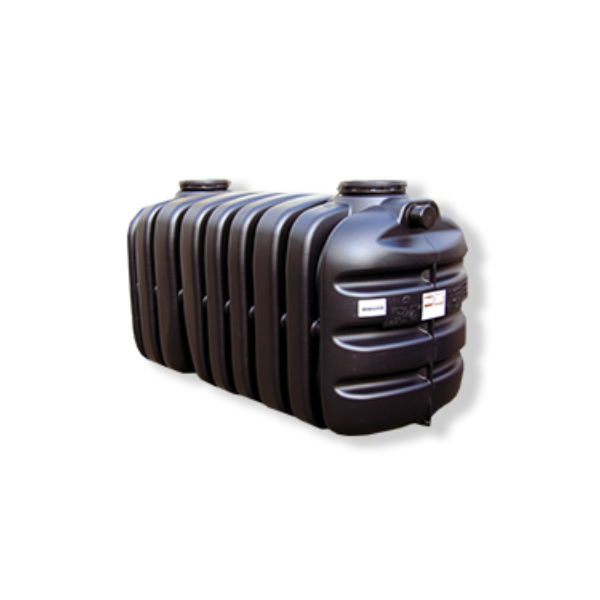
Tricel Vento Septic Tank
Shallow dig tank, strong & robust underground tank, No electrical or moving parts. Ideal for sites with good drainage & plenty of space.
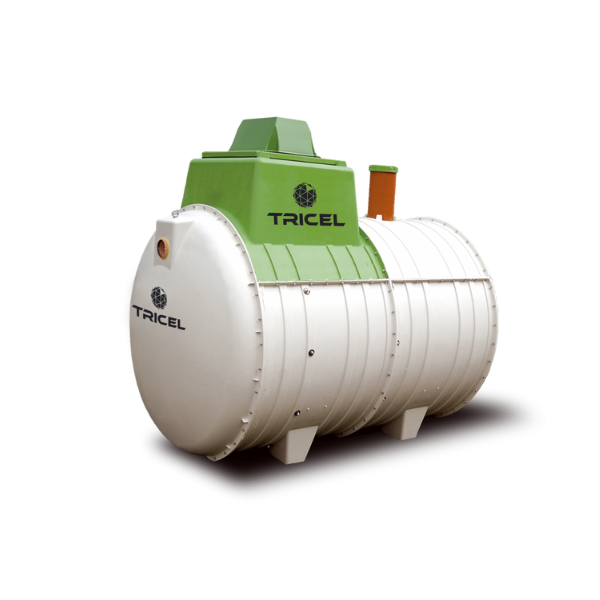
Tricel Novo Sewage Treatment Plant
Durable & long lasting SMC tank, shallow dig tank, easy installation (Plug and Play), long life components.
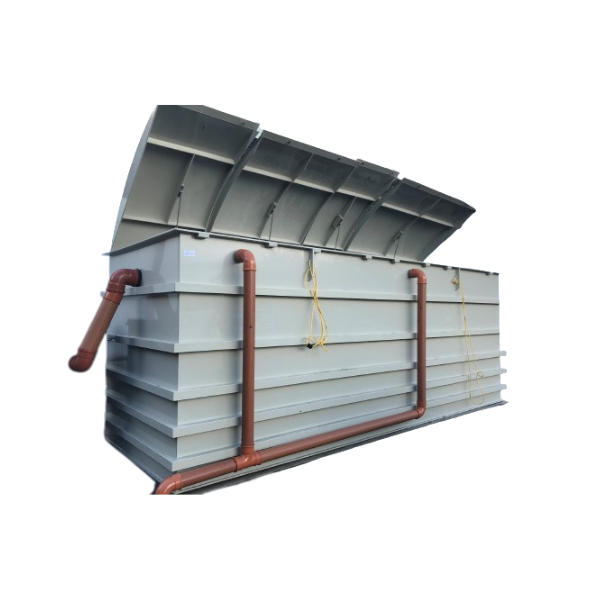
Tricel Maxus Sewage treatment Plant
Commercial plant. Submerged Aerated Filter (SAF) technology. Ideal for every project over 50 Population Equivalent.
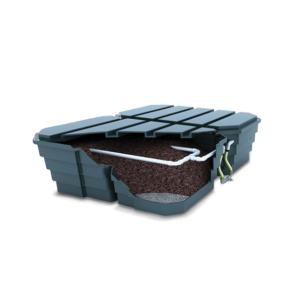
Tricel Puraflo Packaged filter
Ideal for sensitive sites, compliant to British Standard, small footprint.
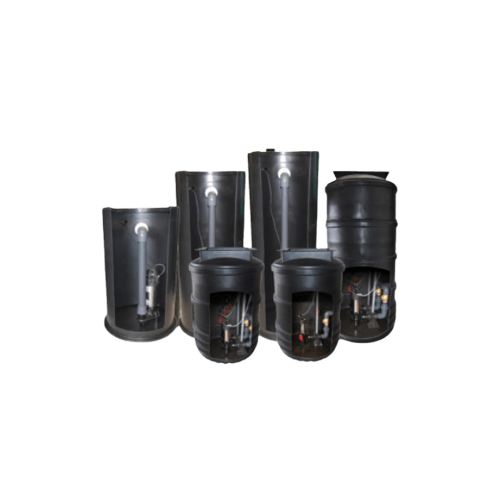
Tricel Pumping Stations
Pump fluids from one place to another where gravity drainage cannot be used, easy and trouble-free installation
50 YEARS IN BUSINESS
A highly successful multinational corporation with over 50 years’ valuable industry experience
SEWAGE TREATMENT PLANTS
Plants available for all capacities, from 1PE up to 50PE. Free advice on request.
FAST DELIVERY
On-time delivery is a core requirement of our successful business operations
Frequently Asked Questions
A cesspool is a simple storage vessel with an inlet and no outlet. It’s a sealed storage vessel; all the water coming in stays within the tank. The advantage is it doesn’t need an outlet. The disadvantages are: there is no treatment, the tanks are huge, and it needs regular emptying. Everything which has gone in must be sucked out. Ideal for sites which have got very infrequent use (Sheppard huts, for example).
A septic tank has an inlet and an outlet; it’s a simple overflow system. See how a septic tank works here. The advantages of the septic tank are there is no mechanic and no electricity requirement for it to work. The disadvantages are you are discharging dirty water, and untreated sewage effluent, as a tiny breakdown has occurred in the tank. You can only release water to a drainage field for the water to go through the subsoil to treat the water.
A sewage or package treatment plant has an inlet and an outlet; the wastewater is treated inside the tank. Aeration is provided inside the tank for the aerobic bacteria to feed on the waste and remove it from the liquid. The advantages are the wastewater is treated and can be discharged to a watercourse.
Many package treatment plants are available on the market:
- Trickles filters
- Rotating Biological Contactors (RBC)
- Mobile media bio-reactors
- Activated Sludge systems
- Sequence Batch Reactor systems (SBR)
- Fixed Bed Systems (like the Tricel Novo)
UK sewage treatment plants must comply with EN 12566-3 2005 regulations.
You should also hire a professional to install your sewage treatment system. For any sewage treatment plants you intend to install, you should also check your local guidelines to determine if planning permission is required.
A sewage treatment plant is where domestic wastewater and sewage are treated. The sewage treatment plants break down organic matter through the primary settlement and aeration chambers. Sewage treatment plants require little maintenance and have low running costs, and sewage effluent is discharged into drainage fields or watercourses.
For example, the required standards are 20:30:20 for BOD, SS, and NH4.
Tricel® has achieved an 11:16:9 result during independent testing.
In order for the biomass to reach its optimum purification, it may take up to 16 weeks.
You may be able to discharge directly into a watercourse or to a percolation area depending on your region. Find out which option is best for you by contacting your local council.
The sewage treatment plant’s size depends on the effluent volume from your house. It is determined by the number of people using the system, which is calculated based on the number of bedrooms in your home. If you need further information, contact our team.
Occasionally, your sewage treatment plant will need to be emptied due to the accumulated sludge inside – usually once a year. The frequency of emptying your treatment plant depends on its size and usage. See our dedicated page about desludging septic tanks and wastewater treatment plants.
1) to prevent surface water from entering the tank and overloading the system as this can inhibit growth of the bacteria and could reduce the effluent quality.
2) to prevent water getting into blower housing which can harm the control panel and the air blower.
Learn more about Tricel Novo risers.
Get in touch
